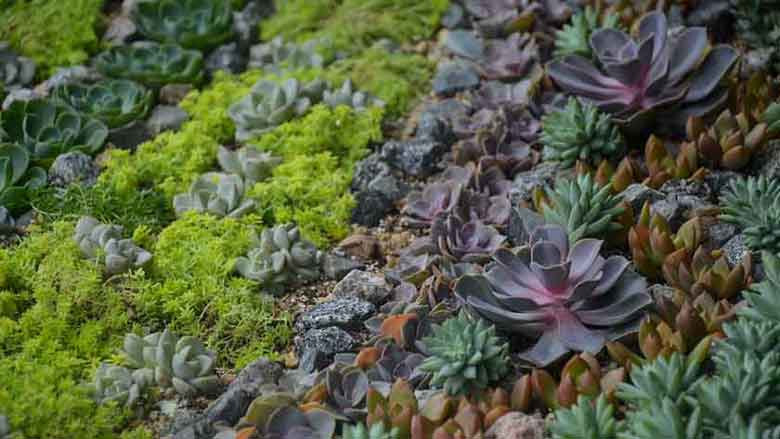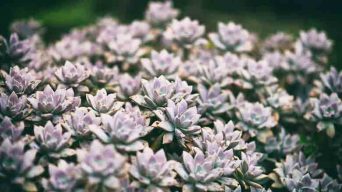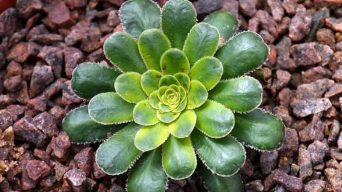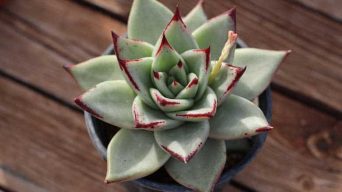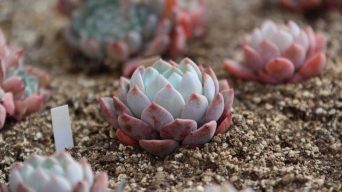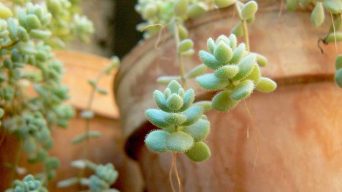Succulents thrive in well-drained soil, ample sunlight with some shade, sparing watering, and appropriate containers. Indoors, they need indirect light, dry feet, and a succulent soil mix. Outdoors, full sun, low humidity, and well-drained soil are key. Choose suitable varieties for your location.
Succulents are a popular type of plant to have around. They don’t need much water, are easy to care for, and look great indoors or outdoors.
But there’s more to succulents than just their low-maintenance nature. Every type of plant has its own set of needs that it must have to grow properly.
Here, we will discuss the best conditions for succulents to grow and thrive.
Where Do Succulents Grow Naturally?
Succulents, as a general type of plant rather than a specific species or variety (such as cactus), can grow naturally in many different types of climates and locations.
They typically have little water needs, so they are often found near deserts with low rainfall.
But they are also found in other semi-arid places like Mediterranean climates that get some rain during the year, yet intermittent drought periods.
These all make for good succulent habitats with insufficient moisture around them and extreme aridity/sunshine levels.
The most common succulents in cultivation today grow naturally along the Mediterranean coast, with dashes of them up into France and Spain.
A few types regularly grow on hillsides inland from there or near coasts where they get more rain (but not too much).
Some other locations include deserts, like those around Southern California and some parts of Africa.
These regions have dry climates but contain areas right next to water reservoirs that provide moisture for life during extended periods without rainfall year-round.
What Conditions Do Succulents Like?
Succulents thrive when there is a balance of moisture and sunshine.
They need to be watered sparingly, but they require water for the plant’s roots to not completely dry out between watering periods. Succulent species are drought-resistant rather than xeric.
Some of the best conditions include shade or shelter from intense sun during hot weather. Many succulent varieties have thick leaves that store heat which can cause sunburns.
Best Growing Conditions for Succulents
Succulents can flourish in a wide variety of climates and conditions. Still, they need some essential things if you want them to thrive.
Best Temperatures for Succulent
Regarding temperature, most succulents thrive in environments with a daytime high of 65°F – 70 ° F.
They can also grow well above this range if given enough shade and protection from the sun during hot hours like noon or early afternoon when temperatures reach 85-95 degrees Fahrenheit (29 C).
When nighttime arrives, around 60ºF is ideal for these plants as their soil will remain moist longer, which helps them keep growing faster.
The temperature in your home or office may not be perfect for these plants as it could fluctuate between too hot and too cool.
There are a few ways you can help succulents thrive regardless of the environment they’re living in:
- Make sure that plenty of sunlight is available to them each day by placing their pots near a window with some direct light coming through during daylight hours. But keep an eye out on how much heat seeps in from outside sources.
- Offer protection via screening off window sills at night, so no artificial heating bursts inside (like patio lights). This helps keep enough natural ventilation when temperatures drop below 55ºf-65°F.
- If you have more than one succulent plant in the same pot, try separating them into two pots so that they each receive adequate sunlight and water.
- Use a humidifier to help combat dry air conditions, which may cause your plants’ leaves or tips of their stems to turn brown.
- Reduce artificial lighting during nighttime hours (especially when temperatures are below 55ºf). This can interfere with photosynthesis, but keep an eye on temperature levels while doing it.
- 6. Adding small pebbles under large planters helps raise humidity by preventing wind from blowing away soil moisture. Some types require less watering frequency due to high ambient relative humidity, whereas others need daily care.
Best Lighting Conditions for Succulents
One of the most important conditions for succulents is lighting.
Most people believe that a lot more light, as opposed to less or no sunlight exposure, will help them grow and thrive better in their environment.
But it’s not so simple. Succulents are a type of plant that prefers to be in the shade.
They don’t like too much direct sunlight, so they need to get some indirect sunlight and plenty of shadows.
Some plants will do better with less light than others. For example, succulents like cacti and echeverias thrive on far more shade. They can be completely shaded from the sun by a simple roof or tree branch.
It should be noted here that these plants need natural daylight (not fluorescent lamps). They also do well with artificial lights, which emulate this sun-like effect on photosynthesis.
Succulent Water Needs
The succulent plant is adapted to dry conditions, so it doesn’t need a lot of watering.
It’s best not to overwater the plants because they can rot easily. This can happen when there are too many wet spots in their potting soil, and they don’t get enough air circulation around them.
The best way to tell if a succulent needs water is by checking its soil.
If it’s dry, you should give your succulent a drink of water and let them take care of themselves from there on out because they’re self-sufficient plants.
But before watering, ensure their potting mix feels thoroughly moist and feels heavy. If the soil feels light and airy, it’s best to wait a few days before watering succulents again.
Best Soil for Succulents
Like any other type of plant, succulents need good soil to thrive. Succulent roots and leaves are used for food storage.
They don’t have many shallow feeder root systems like most plants do. Their ability is limited by the kind or quality of soil it has been planted.
But that doesn’t mean you should skimp on establishing an environment conducive to its growth potential.
For this reason, using cacti/succulent mix as a planting medium for succulents can be helpful because these two substances combine well.
This soil mixture provides excellent drainage through sand, pumice, or perlite while also easily eliminating compacted clay soils (a common problem).
This creates better conditions than what would exist without them being mixed.
Best Containers for Growing Succulents
One of the best conditions for succulents to grow properly is having a good pot or container.
While any type will work, some pots and containers are better than others. Those with drain holes help prevent overwatering, which can be fatal in most cases.
These types include ceramic pots or clay ones that dry out quickly when they’re not watered because there’s very little water stored inside them.
Terracotta planters (a porous material) make it easy enough on plants by letting moisture evaporate through their surface. These also don’t break easily as plastic varieties do, so you won’t have pieces littering your floor!
Plastic also has its setbacks: since all plant roots need oxygen, they’ll develop root rot if exposed for too long without air circulation. The problem is that air doesn’t pass through plastic very well.
Best Fertilizer for Succulents
One of the best things you can do for your succulents is give them fertilizer.
Fertilizer will help promote healthy growth and development in plants and develop a more vibrant coloration on succulent leaves.
Fertilizer is one of those things that are important not just when planting succulents but throughout any stage. It doesn’t matter if you use a natural fertilizer like compost, manure tea, etc. Artificial fertilizers also work well.
If you’re interested in organic fertilizers, compost is an excellent choice for succulents. It’s not only plant-derived but also has lots (definitely more than three) of micronutrients.
After decomposition, microorganisms have broken down all those complex molecules into simpler forms that plants are better equipped to absorb without becoming toxic.
As a bonus, compost can be used both indoors and outdoors.
If you use it outside, you may also want to put a little on the topsoil. Sometimes, the rain falls temporarily before evaporating again, leaving nothing but thirsty roots.
Best Place To Keep Succulents
An excellent place to put your indoor succulent plants for them to grow properly would be underneath a window or near an open door. They can get natural light and fresh air flow there, but not directly next to it.
The best orientation (the angle you’re viewing) should face East if possible, as this will promote growth.
West isn’t too bad either because the morning sun could illuminate the plants when necessary.
At the same time, afternoon sunlight may scorch leaves with more intense heat exposure during peak hours (so ensure plenty of shade nearby).
Best Conditions for Growing Succulents Indoors
The optimal conditions for succulent plants indoors are as follows:
- They grow best in a sunny location with good air circulation and indirect light year-round. However, they can adapt to less sun if the temperature is warm enough (above 50°F).
- The plant should be watered frequently but not too much, or it will rot.
- Succulents don’t like wet feet, so ensure your pot has plenty of drainage holes at the bottom.
- Succulents need to be watered from the bottom or directly into the soil instead of pouring water over the top of the plant, leading to fungal growth on roots.
- Provide a succulent soil mix (don’t use regular potting soil) and fertilize every two weeks.
- Succulents are slow-growing plants, so don’t expect them to outgrow their container quickly. This is good for people who live in apartments with growing restrictions.
- Be sure not to put your indoor plant on an east-facing window as the sun will dry it up too much due to the intense heat waves reflecting off of a south-facing window.
Types of Succulents That Thrive Indoors
Succulents are a popular choice for houseplants because they grow well indoors, don’t need much light, and be grown in many different containers.
The type of succulent you purchase will depend on the environment that is best for it.
If your home or office has more natural light than most buildings, sun-loving types like Echeveria and Sempervivum would be great houseplant choices.
Some of the best indoor succulents are:
- African Milk Tree
- Aloe Vera
- Burro’s Tail
- Christmas Cactus
- Hens-and-Chicks
- Jade Plant
- Panda Plant
- Ponytail Palm
- Snake Plant
- Zebra Haworthia
Best Conditions for Growing Succulents Outdoors
Succulents are best grown outdoors. They survive well in the outdoor climate, especially when they get enough water and sun exposure.
The ideal conditions for outdoor succulents are as follows:
- Full sunlight (i.e., in the direct path of no less than six hours per day).
- Well-drained soil absorbs water easily, such as coarse sand or gravel mixed with a potting mix made for succulents. You should not create a drainage hole too large where roots could fall into it when watering.
- Average daytime temperatures above 70 degrees Fahrenheit but below 95.
- One of the essential conditions for succulents to grow healthy and have strong roots is low humidity levels.
- Fertilize your succulents at least once every two weeks during the growing season by mixing fertilizer liquid concentrate according to the manufacturer’s instructions.
- Keeping succulent plants free from weeds can reduce pest infestation frequency while ensuring their overall health and growth.
- Let the soil dry out slightly between watering sessions, but not so much that the succulents look shriveled or wither.
- Let succulents go dormant during winter months if the area becomes cold enough.
Types of Succulents That Thrive Outdoors
Succulents are a popular choice of indoor plants for their ability to thrive in dry conditions and low light.
However, not all types of succulents are suitable for an outdoor garden.
The most common types that do well outdoors are:
- Aeonium
- Agave
- Crassula
- Dudleya
- Echeveria
- Euphorbia
- Graptopetalum
- Haworthia
- Kalanchoe
- Sedum (Stonecrop)
- Sempervivum
- Senecio
Final Thoughts
There are a lot of different factors that go into determining the best conditions for growing succulents.
These include sun exposure, soil moisture levels, and variety selection based on the grower’s climate region or purpose.
You must consider that the ideal growing conditions can vary from one variety of succulents to another.
So, it all depends on what you want to obtain better results when growing your succulent plants.

